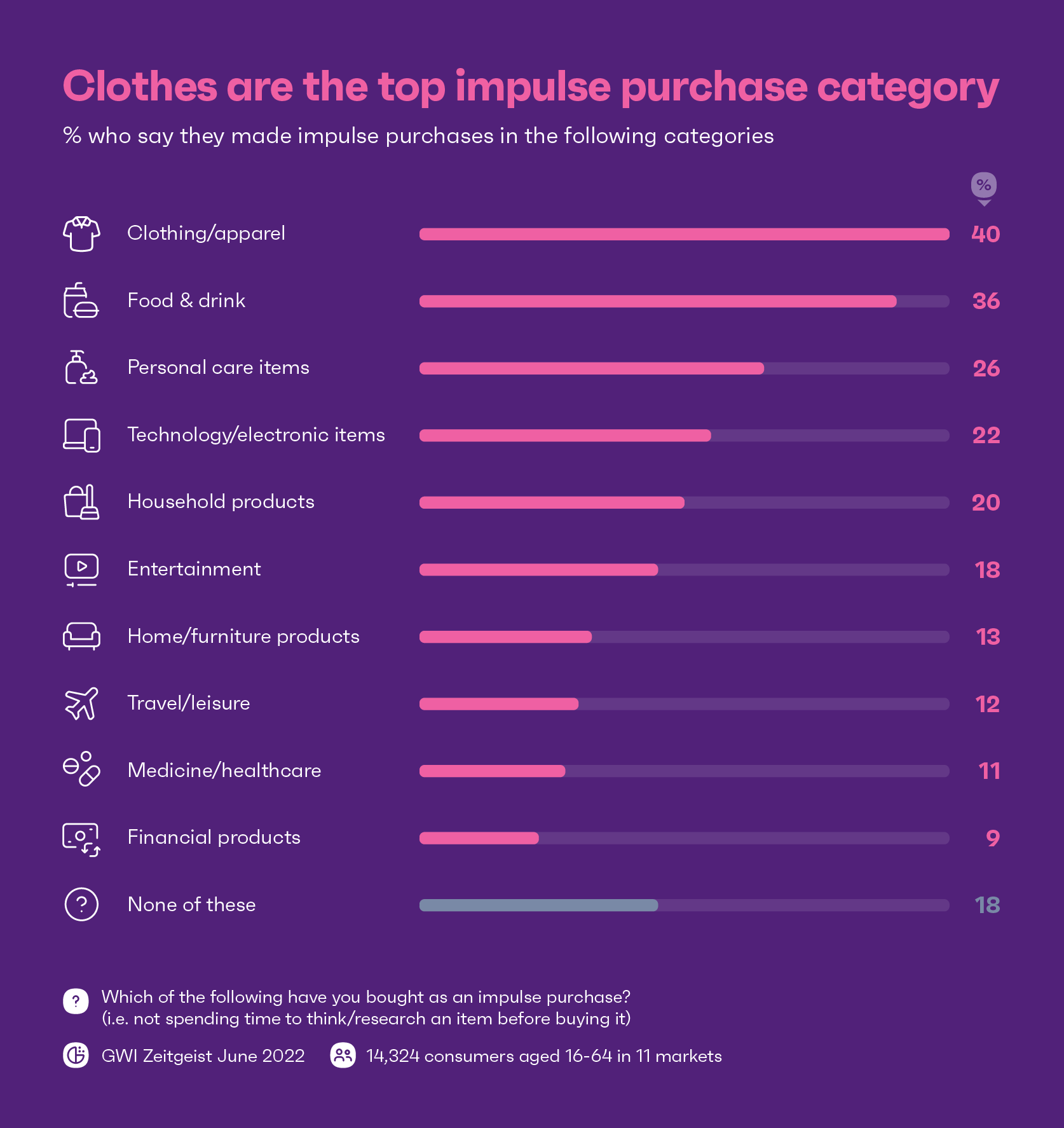Have you ever gone into a store just to browse, or with a specific item in mind but end up walking out with a few unexpected purchases? You’re not alone – consumers around the world make impulse purchases on the regular.
Impulse purchases are items bought without doing research or spending much time to think about it before buying. These can range from a shirt that catches your eye to a travel-sized tube of toothpaste before a vacation.
Globally, consumers are feeling the impacts of the rising cost of living, and with budgets tightening, they have to decide what is worth the spend and what can wait. 41% of consumers say they are going to spend less on treats and luxuries due to the rising cost of living, yet impulse purchases creep into even the tightest of budgets.
So with all of this in mind, what are consumers impulsively spending their money on? How many consumers are disciplined enough to say “no” and which ones (guilty as charged) are not?
1. Clothes, food, and drink are the most popular impulse purchases
Clothing is the most popular category for impulse purchases. Fast fashion brands influence this by making appealing clothes affordable for many consumers. This past quarter, clothing was one of the most popular items to buy in general, with 47% of consumers having bought clothes in the last month. It was also the leading item bought online, with 22% of consumers doing so.

Food and drink is the next most impulsively bought item, but this may decline as consumers purge unnecessary spending. With the cost of living rising, impulse purchases of food and drink seem to be the first cost cut. 40% of consumers cite eating out as one to go, and 46% say they will try to eat at home more. Recently, Grubhub partnered with Amazon Prime to give out free premium Grubhub memberships to Prime members in hopes of not seeing a dip in sales.
Clothes, food and drink are essential purchases for many, so it is not surprising to see them number one and two for top impulse purchase categories. Even with the cost of living increasing and consumers being wary of their spending habits, consumers say they aren’t planning to cut back on clothing purchases (25%) as much as eating out and socializing (40%). The fashion industry rapidly goes through trends, and consumers, especially younger ones, try to keep up. With fast fashion brands offering trendy clothes for an affordable price, being trendy is to many, an acceptable luxury.
2. Impulse purchases influence US Gen Z
Americans are more likely than global consumers to think their personal finances (1.27 IDX) and the US economy (1.83 IDX) will get worse in the next 6 months. Needless to say, they are not likely to be making impulse purchases often.
In Q2 2022, only 20% of all US consumers said they often make impulse purchases, but leading the pack is Gen Z, who are more likely to be spontaneous shoppers.

Gen Z are very much influenced by trends. 22% say they are influenced by what is cool and trendy, 93% more likely than the average American. This could be a big factor for impulse purchasing, and social media drives this hype. For instance, the Travis Scott Meal at McDonalds, which trended on TikTok, brought in millions of dollars in sales. Gen Z consumers in the US are 38% more likely to be using social media to avoid FOMO than the average American social media user, and simply passing a McDonalds could have triggered a sale.
While Gen Z are more likely to make more impulse purchases than the average US consumer, this might not last long, as they too are becoming increasingly pessimistic about their finances and the economy. 41% of Gen Z think the US economy will get worse in the same time frame, a year-on-year increase of 54%. The new trend for Gen Z to follow seems to be saving money.
3. Online impulse purchases are rarely returned
Impulse purchases aren’t limited to brick-and-mortar stores. 59% of consumers prefer shopping online, so naturally, impulse purchases are made over the internet. While many digital impulse purchases have been made, this does not mean more online returns of those items.

For consumers who say they’ve returned an item online in the last 3 months, less than 15% cited impulse buying as a reason. Instead, size and fit was the most common reason for return (47%), while product not meeting expectations (37%) and product being faulty/damaged (36%) were right behind. Coincidentally, consumers also say that a detailed description of sizing (40%) and of the entire product (e.g. materials used) (38%) would help reduce the numbers of online returns they make. Including these important factors on online items could help reduce returns.
Returned items can be a huge financial burden to online retailers. Recently, fast fashion giant Zara joined the likes of H&M and Uniqlo by no longer allowing free online returns, and although Zara have not reported a drop in sales, another key deterrent for many consumers making online returns is paying for them. 46% of consumers in 11 markets who’ve made an online return in the last 3 months say they’d be unlikely to return items online if they had to pay for it, and 77% of US consumers who’ve made a recent online return say the same.
It seems that even if an impulsive purchase doesn’t work out, fees for online returns is enough of a deterrent for most US consumers when it comes to sending those items back. Even more, brands can include more detailed descriptions about sizing and the product’s background to cut down on online returns being made, as these temper consumer expectations and give them a clear picture of what they’re buying.
4. Free shipping is key
Offering free shipping with online purchases can turn an abandoned online shopping cart into a real purchase. It is the most important thing to consumers when shopping online, and paying for shipping is among the top complaints of those who didn’t complete a purchase online.
Free shipping has a large effect on impulse purchases made online. Only 11% of consumers indicated that they returned items online because they were bought solely to qualify for free shipping. Many retailers increase prices to cover free shipping, and consumers are ok with this, as 50% of consumers say that free delivery is the most likely to increase an online purchase, compared to just 39% who say discounts.
Small actions like including free shipping not only foster more impulse purchases, but make the customer journey more pleasant as a whole. 44% of consumers worldwide are loyal to the brands they like, and getting rid of the #1 online shopping complaint – not having free shipping – is a surefire way to increase loyalty. Those who are loyal to brands they like are 16% more likely than the average consumer to cite free shipping as something that increases their likelihood of buying a product online.
5. Planned or unplanned – loyalty wins
When consumers know they are getting a high-quality product from a brand, they don’t need to second guess the decision.
As more consumers are spending their time shopping online, free shipping on online purchases makes them more likely to finalize their purchases. Detailed sizing and product descriptions give consumers a clearer idea of what they’re buying so they won’t need to think twice about their hastiness – they know they’re going to get a quality product that won’t need to be returned. But above all, taking steps towards meeting the expectations of consumers means they’re less likely to reconsider.



